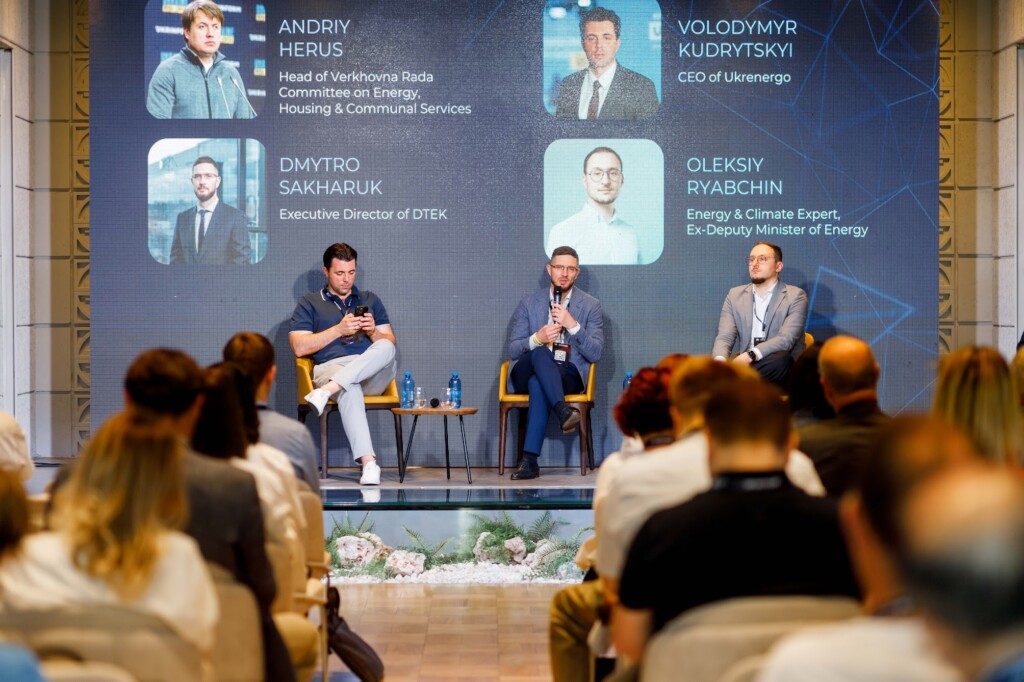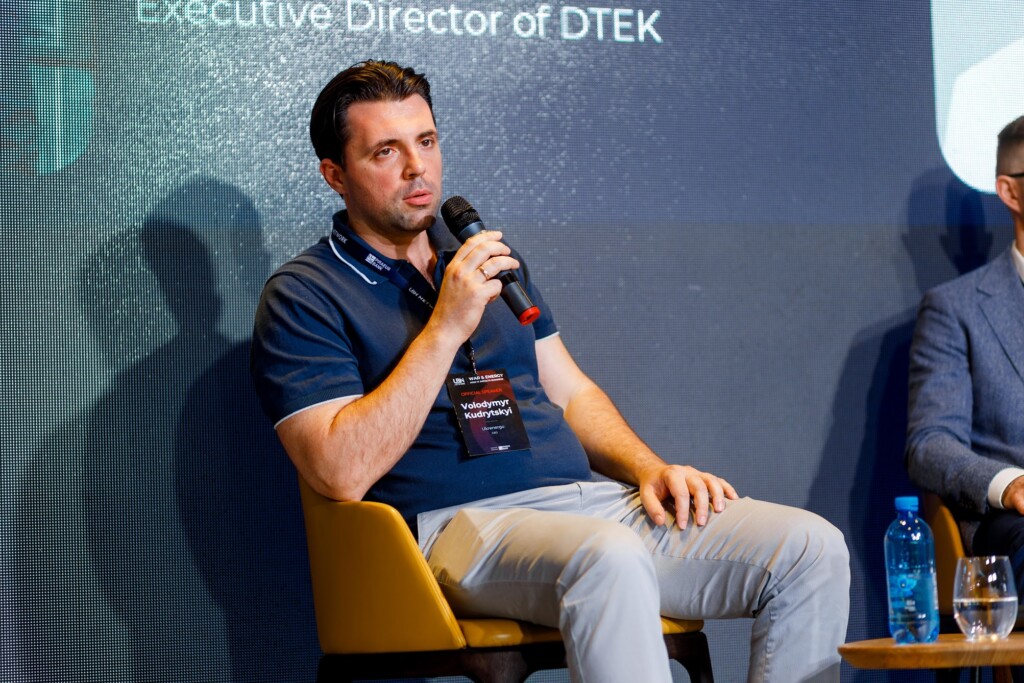Ukraine’s electricity blackouts could last for years, but it can be much worse


The latest Ukraine Business News quarterly event brought together the nation’s largest private energy producer, DTEK, and the state’s electrical distributor, Ukrenergo, for a distressingly candid discussion of the nation’s energy crisis.
At the June 21 event organized in Kyiv’s Parkovy Congress Center, Volodymyr Kudrytskyi, the CEO of Ukrenergo, and Dmytro Sakharuk, the executive director of DTEK, described the stark situation that is all too familiar to Ukrainians who spend hours at a time every day in homes or businesses without electricity.
“We face the biggest electric challenge in the history of humanity,” Ukrenergo’s Kudrytskyi said during the hour-long “War & Energy” networking event moderated by UBN partners Andrew Pryma and Mark McNamee.


Russian attacks ‘will probably continue’
Russia’s “plan is to destroy the power system to initiate a full long-term national blackout which would cause catastrophic consequences for Ukrainians, for the economy, and for our ability to fight. So this is one of the dimensions of the war, the battle in the energy sector and, unfortunately, we have deal with the reality that attacks will probably continue. We have to be ready and we have to recover as much generation as possible before winter,” Kudrytskyi said. “We have to ask for extra air defense to protect what we recover but also we have to roll out new generation facilities to make sure that if Russians undertake these attacks, they cannot concentrate on 10 or 15 big power plants but they would have to deal with hundreds of smaller ones.”
Ukraine’s energy infrastructure has been pummeled in waves of attacks by Russia since from almost the start of the full-scale invasion in February 2022. Or it has been stolen. Its troops have occupied Ukraine’s largest nuclear power plant near Zaporyzhzhia since March 2022, cutting the country’s nuclear power generation by nearly half, with three nuclear plants remaining in Ukraine’s hands.
The Kremlin also began sustained bombing of energy infrastructure in September 2022. Last year, Russia damaged all thermal and hydropower plants and half of the transmission substations, Kudrytskyi said, forcing repairs.
Altogether, Russia has knocked out or seized more than half of Ukraine’s pre-2022 electricity generating capacity—from 55 gigawatts (GW) to 20GW. It will take up to $50 billion to fully recover. Russia’s stepped up its attacks since March of this year alone, destroying 9GW—about half of the nation’s remaining generating capacity—with strikes on thermal and hydroelectric power plants.
Since then, managed power cuts have been the norm across the nation, adding to the economic and emotional toll of the war.
Worse, estimates are that as little as 7 percent of the nation’s generating capacity may be restored by winter – guaranteeing many cold, dark and dangerous days ahead for Ukrainians and hard times for their economy and military. Restoring even half of the 9GW in destroyed capacity in strikes since March 22 will require billions of dollars in investment, loans and supplies – all of which is lacking in Ukraine.
How bad is it?
Russian bombs destroyed 90% of the production capacity of DTEK, owned by the nation’s richest billionaire, Rinat Akhmetov. DTEK hopes to restore about 50%, or a maximum 3GW, of “what we had before the March 22 (strikes), not more,” Sakharuk said. “Again, if it’s protected, because we did this several times already.”
It is so bad that Akhmetov’s DTEK CEO Maxim Timchenko is making public pleas for money with his “Fight for Light” campaign to help restore power plants for the company, whose owner has an estimated net worth of $7 billion.


It is so bad that Kudrytskyi said Ukraine cannot import enough electricity to solve the problem because the current European export capacity to Ukraine is 1.7 GW, or possibly 2.2 GW maximum, and it would take years for Europe to build more transmission lines. The current import cap will not be enough to make it through the winter without power cuts. Last winter, Ukrainian President Volodymyr Zelensky said the nation had a peak consumption of 18GW.
Water, sewage systems need protection.
But it could be worse.
DTEK’s Sakharuk noted that the biggest problem would be “the absence of sewage and water. If you sit in the flats without electricity, it’s fine. You can get (it from) somewhere, bring some power, charging. But if there is no water, if your toilet doesn’t work, then forget about staying in that apartment.”


It is not for lack of Russia’s trying.
Ukraine Business News reported on April 5 that Russian attacks have left 36% of Ukrainians without consistent access to water supply and sewage services, citing Ukrvodokanalekologiya Association President Dmytro Novytskyi. While restoration is ongoing, $11B in damage has been caused by the ongoing Russian strikes. Throughout 2024, an estimated 8 million – nearly a quarter of the remaining Ukrainians – “will have limited access to centralized water supply and sanitation in 2024,” Novytskyi estimated.
Short-term solution: Stronger air defenses, quick repairs of thermal and hydro plant
Repairing the damaged infrastructure will be a waste of time and money unless Ukraine gets stronger air defenses from its Western partners to prevent future strikes on the electrical, water and sewage systems.
“So even if we start recovering, we start repairing, there’s no means right now to protect the recovered units,” Sakharuk said. “We had two attacks in March, two in April, one in May, two in June. Basically, all our five plants were attacked four or five times.”
Ukraine is believed to have at least four of the U.S.-made Patriot systems, considered the premier air defense weapon, with more on the way. Zelensky estimated that 27 would be needed to protect the entire country or at least seven to cover the major cities. It is negotiating for additional Patriot systems, which cost $1 billion apiece, from several countries, including eight from Israel alone.
But unless Ukraine’s energy infrastructure is safe from future attacks, all predictions are futile, and all repairs may be a waste of money.
“If somebody can tell me what these (Russian) attacks will be, what units will be damaged, and to what extent, I will be able to tell you more or less exactly how many hours you will have disconnected in winter,” Kudrytskyi said.
Long-term solution: Remove obstacles to investment, decentralized power system
In the long run, Ukraine will have to restructure its energy supply system entirely, relying more on decentralized power production and transmission systems, including greater use of renewables such as solar and wind.
But to achieve this better future, Ukraine’s investment climate will have to improve dramatically—through improved rule of law, adequate risk insurance, and the lifting of currency restrictions so lenders can be reassured that their loans will be repaid.
Generating 1GW of electricity costs roughly $1 billion, Sakharuk said, which means at least $35 billion in fresh investment is needed if Ukraine plans to reach its pre-2022 generating capacity of 55GW.
Despite Akhmetov’s investment of “almost a billion dollars to help Ukraine” since the full-scale invasion, DTEK is in bad financial shape because cannot generate revenue if it is not making electricity. “We need to spend $350-$400 million only to recover 50% of our capacity, considering that we don’t produce right now. There is just no revenue,” he said.
Sakharuk also said that the Ukrainian government’s policy of subsidizing electricity rates for consumers, its preference for spending money on incompetent public sector suppliers and its currency restrictions are all deterring investment.
The subsidies have encouraged wasteful consumption, he said, while starving energy producers of capital to reinvest. “Even now, when the tariff price was increased, they pay a bit less than 50% of the market price,” he said, while many consumers who refuse to pay their bills are protected from utility shutoffs.
Moreover, the DTEK executive said that the state-dominated banking sector does not provide enough loans to the private sector. He faulted the domestic banks for making easy and guaranteed profits by lending money to the National Bank of Ukraine. Unless Ukraine’s banks start investing in the energy sector, he said, international banks cannot be expected to take the risk either.
“Once we start thinking that capital is universal, basically, and we need to compete based on the universal rules of the capital economy, capital will come,” he said.







